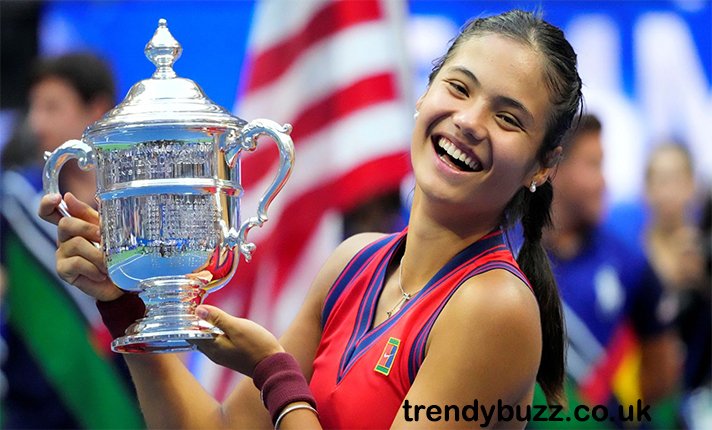Introduction
Emma Raducanu rose from relative obscurity to global attention with a blend of calm power and quick footwork that marked her as one of the most exciting young players in tennis. Her breakthrough felt like a sports fairy tale: a teenager who navigated the qualifiers and then swept through a Grand Slam draw without dropping a set, an achievement that rewrote expectations for newcomers.
A defining moment came at the 2021 US Open, where Raducanu became the first qualifier in the Open era to win a singles major. That victory not only earned her a place in tennis history but also triggered a surge of public interest, sponsorships, and expectation that would follow her for years.
Background and development
Born in Toronto to a Romanian father and Chinese mother and raised in Bromley, London, Raducanu balanced school with intensive training as she rose through Britain’s junior ranks. Her early years were notable for a steady focus on technique and an ability to perform under pressure, traits common among players who transition quickly to the professional level.
Injury setbacks and recovery
Raducanu’s career has not been a straight line. After the initial burst onto the scene, she struggled with injuries that required surgery on both wrists and an ankle, forcing lengthy absences from the tour and disrupting the rhythm so important for match fitness. Her rehabilitation and cautious return to competition were closely watched, with many commentators pointing out that managing her physical health became as important as refining tactics.
A gradual comeback
As she returned to full training and match play, Raducanu worked with a series of coaches and support staff. Recent seasons have shown signs of tactical maturity and an expanded game plan that mixes aggressive baseline hitting with sharper serving choices. The WTA’s coverage of her recent tournaments highlights a player trying to rediscover consistency while adapting her schedule to protect long-term fitness.
Recent form and tough losses
Even in periods where the scoreline looks mixed, Raducanu has shown flashes of high-quality tennis. A recent match in Beijing underlined both her progress and the fine margins in elite competition: she came close to victory against a top opponent but was unable to convert match points, a result that exposed the mental and tactical polish she still seeks. Such matches are reminders that rebuilding at the top level is rarely linear.
Playing style and strengths
Raducanu’s game is built around balance between attack and defense. She moves well for her height, constructs points with a reliable backhand and a forehand capable of sudden penetrative winners, and has a return of serve that can put pressure on big servers. When she finds rhythm on serve and minimizes unforced errors, she can compete with any top player on tour.
Depth and mental game
Tennis at the elite level is as much mental as it is physical. For Raducanu, the challenge has been translating confidence from practice courts and smaller events into the closing moments of big matches. Close losses that follow long, high-quality sets can sap momentum, but they also offer precise lessons about tempo, shot selection and how to manage nerves when every point feels amplified. Players who recover from similar stretches often describe a phase of match sharpness where repetition and small wins rebuild belief and timing.
Training and support
Behind the scenes, a player’s support network matters enormously. Coaches, fitness trainers, physiotherapists and sports psychologists all play roles in building a schedule that balances intensity with recovery. For a player returning from surgery, that means shorter lead-ups to events, more targeted conditioning and a willingness to skip tournaments if the long-term gain is greater than short-term exposure. Clubs and national programs increasingly provide resources to make those decisions data-informed while still allowing room for individual coaching preferences.
Fans and expectations
The public interest generated by a rapid rise can be double-edged. On one hand, it brings sponsorships, visibility and financial security that allow a player to focus on training. On the other, it raises expectations that can feel unrealistic, especially after injuries. Raducanu has shown an ability to answer tough questions about pressure with a surprising level of candour, which suggests she understands the platform she occupies and the importance of pacing her career growth.
Off-court life
Her off-court life has been almost as visible as her results. High-profile endorsements and media appearances expanded her platform but also added public scrutiny. Raducanu has tried to navigate that attention carefully, prioritizing recovery and training when necessary while retaining a marketable public profile.
What success might look like now
Success for Raducanu may no longer be a single defining slam but rather a year of sustained progress: consistent third- or fourth-round appearances at majors, wins over top-20 opponents, and the accumulation of ranking points that permit more strategic tournament selection. That steady path has brought many players back to their peak after difficult seasons; it insists on patience but rewards it with durability.
Looking ahead
The path for Raducanu is clear in one respect: consistency and health need to be the foundation of any long-term climb back toward the top 10. If she can string together regular match play and sharpen the mental edge that decides late-match moments, the talent that produced a Grand Slam win remains very much present. Fans and critics will watch for the next stretch of tournaments to see whether incremental gains translate into deeper runs and restored ranking stability.
Conclusion
Emma Raducanu’s story so far is a study in contrasts: sudden glory followed by difficult recovery, flashes of brilliance amid a search for steadiness. That combination makes her compelling to follow — not because the arc is guaranteed, but because every match now offers a chance to see how resilience, coaching and careful scheduling can remake a promising career. At 22 she has time; if she remains healthy, refines closing instincts, and keeps a balanced schedule, the combination of talent and experience makes a return to the sport’s highest levels realistic. again.
